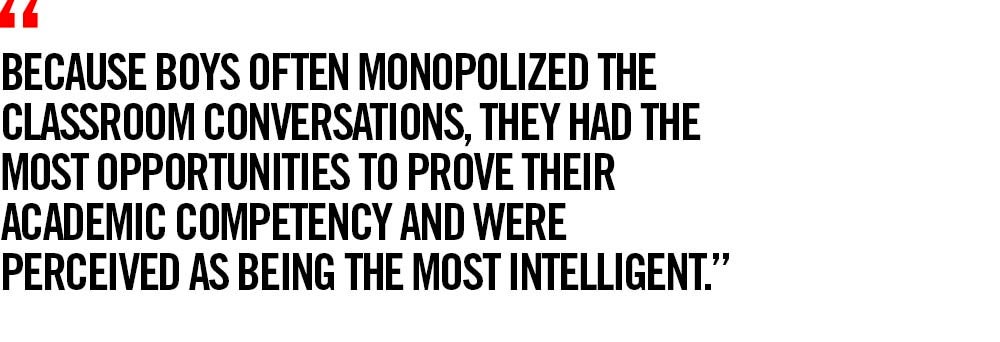Three dozen eager students arrive ready to debate in Mr. Green’s sixth-grade honors English class at Mountain Heights Middle School (MHMS), a high-performing, racially and socio-economically diverse public school in suburban L.A. Today, the class is discussing a hypothetical ban on selling soft drinks in local grocery stores. But before the discussion can even begin, Tristan, a white boy, interrupts to declare, “I’m turning 12 in this class at 11:03!”
“Okay, very good,” Mr. Green patiently responds, before explaining the ground rules for the discussion: Raise your hand and wait to be called on before speaking, and only one person speaks at a time. He then calls on Christine, a white girl with her hand raised. “This ban is arbitrary,” she argues, noting that despite the prohibition of soft drinks in grocery stores, she could simply purchase one at a gas station across the street.
“No you can’t!” Tristan blurts out, interrupting again. Mr. Green glares in his direction but doesn’t say anything. Moving along, he calls on Vivian, an Asian-American girl with her hand raised, who adds that the ban has “so many loopholes.” Vivian is unable to name one, though, before two other boys interject and contest her point. Mr. Green smiles and reminds the class to “stay within the format.”
Several minutes later, at exactly 11:03 a.m., Tristan interrupts yet again to announce, “It’s my birthday right now!” Mr. Green ignores the comment and calls on another student.
Mr. Green might’ve gotten upset with Tristan after the first time he interrupted, explains Michela Musto, a postdoctoral fellow at Stanford’s Clayman Institute for Gender Research, and even kicked him out of class on the second or third infraction. Instead, she tells me, he responded with tolerance by saying, “Okay, very good,” thereby subtly encouraging similar interruptions from the other (predominantly white and Asian) boys, despite similar outbursts being prohibited elsewhere in the school.
Musto knows this because from December 2013 through the spring of 2016, she observed the same group of 35 students at MHMS, hoping to better understand students’ daily experiences in middle school. (Her findings were published last month in the American Sociological Review.) Shortly after embedding with the sixth graders and upon identifying certain gender differences, Musto narrowed her focus to specifically zero in on how teachers unduly enforce the rule that students are to raise hands rather than interrupting.
She wondered if broader patterns of gender inequality are implicitly learned in middle school. After all, girls are currently outperforming boys in nearly every aspect of education, including grades, high school graduation rates and college enrollment and completion. Despite these facts, though, men are often perceived as being more exceptionally intelligent and better suited for high-status positions within highly-competitive STEM fields and Fortune 500 companies. “It’s often men — especially white men — who dominate these positions,” Musto notes.
Could this phenomenon be traced to Mr. Green’s sixth-grade honors English class?
Perhaps.
In the study, “Tristan challenged Christine’s opinion right away,” Musto explains, which she says caught Christine off-guard, thereby denying her the opportunity to potentially be praised for her insights as boys often were — they were far less likely to be interrupted. In fact, when Tristan and the other boys interjected — or whispered amongst themselves, which they also did throughout the class — Mr. Green either ignored them or patiently reminded them to behave, responses Musto regularly observed from MHMS teachers.
In Mr. Carr’s sixth-grade honors math class, for example, when students were asked to answer a complex word problem, despite two girls and one boy raising their hands, Tristan again blurted out the answer. Rather than reprimanding him for speaking out of turn, Mr. Carr clapped his hands and proclaimed, “This guy here? Genius!”
And so, not only did boys have more opportunities to speak in honors-level classes, they also had more opportunities to be praised. On the flip side, because girls’ opinions were often challenged, they were denied the opportunity to speak up and/or be commended, a fact not lost on Skyler, a multiracial Asian-American and Latinx girl who admitted it was often “hard to find a space” to make a comment.
Case in point: In a sixth-grade advanced math class, Kaylee was reciting digits of pi when William interrupted. “There are no o’s in numbers,” he loudly corrected. “They’re zeros, not o’s.” But the teacher, Ms. Kiefer, left William’s behavior unaddressed, and Kaylee stopped speaking, quietly turning her attention to a worksheet. When Musto spoke to Kiefer about the incident later, she acknowledged having “lots of issues” with William as a student. Rather than condemning his behavior, though, she explained that “really intelligent boys like William simply needed to learn humility.”
It’s a stark departure, Musto notes, from the way educators talk about boys in urban school districts, where similar outbursts from African-American and Latinx boys are often interpreted differently. “If William had been a student of color in a different context, educators might have assumed that he was on a pathway toward prison or criminality,” she explains.
By the time boys reached eighth-grade honors classes, Musto says that while they now adhered to proper classroom etiquette, they also began dominating speaking opportunities. Basically, their earlier experience of interrupting had a residual effect: with more practice speaking over students than girls, they were more confident dominating classroom discourse. Meanwhile, years of repeatedly being interrupted and challenged by boys negatively affected higher-level girls’ confidence. Unlike the boys, honors-level girls tended to describe their eighth-grade selves as “nervous,” “quiet” or “shy.”
“From the perspective of students who don’t necessarily know what other students’ grades are, one of the main ways of figuring out who’s smart and who’s not is based on the types of comments peers are offering,” Musto says. “And because boys often monopolized the classroom conversations, they had the most opportunities to prove their academic competency and were perceived as being the most intelligent.”

Since these findings were based on just one middle school class, though, I spoke separately with a dozen middle school teachers from across the U.S. to get their opinions on Musto’s findings.
“It sounds accurate from my experience,” says Shawn Smith, a middle school teacher, principal and Chief of Schools who holds a master’s degree in middle-level education and has worked for 15 years in school districts in Illinois and California. He’s quick to note the significance of varying maturity levels amongst middle schoolers before also identifying sixth-grade boys as constant interrupters, which he says is largely due to boys being two years behind girls developmentally at that age. Still, as Musto observed, Smith has seen a number of these boys grow into perceived intellectual superstars two years later.
“I call them mini Judge Kavanaughs,” says Kyle Simmons, a Magnet Coordinator for a middle school in suburban L.A. who asked me not to use his real name for obvious reasons. He’s particularly galled by the male privilege on display in his school’s honors programs, where he says girls are intellectually pushed to the side while being intimidated by “sporty” white boys from wealthy families. (“Sporty,” he says, is code used by parents and teachers to indicate “not gay.”)
As evidence, Simmons points to the school’s coveted, male-dominated “Math Lab.” Photos from the Math Lab’s annual trip to the East Coast reveal a club that’s 80 percent male, with a smattering of shy girls looking on. Next year, Simmons is launching a new magnet program with a mission of promoting gender equality in the classroom. The first lesson will be a research project on how “pink for girls” and “blue for boys” began, designed to build critical thinking about gender norms.
Others, like Abigail James — a middle school teacher of 30 years and author of Teaching the Male Brain: How Boys Think, Feel and Learn in School — are more skeptical of Musto’s findings. While James concedes that the paper does a “very good job” of identifying issues related to gender-based middle school learning, James says Musto is looking at it from a feminist viewpoint while making assumptions that don’t hold up from a teacher’s perspective. “Of course there are boys blurting things out in sixth grade,” she says. “You try teaching 35 12-year-olds in the same classroom. It’s an art form.”
She’s also critical of the idea that boys are being identified as exceptional, believing them to simply be “loud and noisy.” She suggests what Musto actually observed were teachers who paid more attention to boys so they could keep them under control. “It bugs the crap out of me when young feminists identify problems and immediately conclude that guys have to step back. No, girls have got to step forward. Why are we letting young ladies get away with not engaging, while complaining that the teacher didn’t call on them? Well, raise your hand, babe!”
Interestingly, it’s in regular-level classes where girls — especially Latina girls — excel the most. “I call them my secret geniuses,” explains Ellen Abramson Cohen, a seventh-grade English teacher at a public school in L.A., adding that her lower-level classes tend to require stricter discipline. This, too, is borne out in Musto’s paper: Because rules against interrupting were more likely to be enforced in non-honors classes, girls had greater participation in classroom discussions and described themselves as “confident” public speakers. A good example: When Marina, a Latinx girl in Mr. Green’s standard sixth-grade English class, was in the midst of presenting her thesis, a boy tried to interrupt her; this time, however, Mr. Green instructed him to hold his comment until Marina was finished. That not only gave Marina a chance to practice her public speaking skills, but she was also praised for presenting “three concrete and provable details.”
Yet, because these girls were in lower academic courses, they still remained inferior to the real geniuses: the white and Asian boys in honors classes.
That said, a number of the middle school teachers I spoke with believe this is changing. Cohen attributes this to girls seeing more women in positions of power, like Alexandria Ocasio-Cortez. “They’re realizing that they don’t need to tie themselves to being a nurse, ballerina or mother, and can instead use their brains to stand out.”
Nor do middle school girls view a career in STEM fields as out of reach, according to Ann Zeller Rice, who’s taught seventh and eighth science for the past 20 years and points to a “deliberate effort” in middle schools nationwide to change the long-held belief that it’s unladylike to give a girl a soldering iron for her birthday. “Steps are currently being put in place so that in 15 years, women will enter the workforce as programmers, drones builders and all the things they can’t be today because no one was teaching girls how to do them 15 years ago,” she explains.
“Now we are.”

